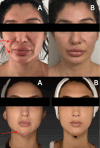Enzymatic Management of Facial Overfilled Syndrome: A Case Series and Narrative Review
- PMID: 40781937
- PMCID: PMC12334978
- DOI: 10.1111/jocd.70377
Enzymatic Management of Facial Overfilled Syndrome: A Case Series and Narrative Review
Abstract
Background: Facial overfilled syndrome (FOS) is an increasingly recognized complication of injectable aesthetic procedures, characterized by undesirable facial volume and contour irregularities. While hyaluronidase is well-established for managing hyaluronic acid (HA) filler complications, treating FOS caused by non-HA fillers, such as fat and silicone, remains challenging.
Objective: This study aims to present the results of a novel enzymatic therapy combining hyaluronidase, collagenase, and lipase for treating FOS in five patients with complications from HA, fat, and silicone fillers. Additionally, we conducted a narrative literature review of studies published between 2015 and 2024, focusing on FOS and its management.
Methods: We performed a narrative literature review using PubMed and Google Scholar databases, identifying six key papers that specifically address FOS. Following this, we present a case series of five patients treated with a combination of 1.5 mL collagenase, 1.5 mL hyaluronidase (HASA), and 1.5 mL lipase (total volume: 4.5 mL). Enzymatic therapy was administered via cannula under ultrasound guidance, and outcomes were assessed through clinical evaluation and patient-reported satisfaction.
Results: All five patients significantly improved facial volume and contour restoration after a single treatment session. The enzymatic combination effectively addressed complications from HA, fat, and silicone fillers, with no significant adverse events reported. Patient satisfaction improved significantly, highlighting the psychological benefits of the treatment.
Conclusion: Combining hyaluronidase, collagenase, and lipase represents a safe and effective approach for managing FOS caused by various filler types. Our study, supported by a narrative review of six key papers on FOS, underscores the importance of tailored enzymatic therapies in aesthetic medicine and calls for further research to optimize treatment protocols and expand the evidence base.
Keywords: collagenase; hyaluronidase; lipase; overfill face; overfill syndrome; recombinant enzymes.
© 2025 The Author(s). Journal of Cosmetic Dermatology published by Wiley Periodicals LLC.
Conflict of interest statement
The authors declare no conflicts of interest.
Figures



References
-
- Kurtti A., Charles C., Jagdeo J., and Nguyen J., “Combination Facial Aesthetic Treatment in Millennials,” Journal of Drugs in Dermatology 21, no. 1 (2022): 37–42. - PubMed
-
- ISAPS (I.S.O.P.S.) , “International Survey in Aesthetic/Cosmetic Procedures in 2023,” 2023, https://www.isaps.org/media/rxnfqibn/isaps‐global‐survey_2023.pdf.
-
- Chiang Y. Z., Pierone G., and Al‐Niaimi F., “Dermal Fillers: Pathophysiology, Prevention and Treatment of Complications,” Journal of the European Academy of Dermatology and Venereology 31, no. 3 (2017): 405–413. - PubMed
-
- Cotofana S., Gotkin R. H., Frank K., Lachman N., and Schenck T. L., “Anatomy Behind the Facial Overfilled Syndrome: The Transverse Facial Septum,” Dermatologic Surgery 46, no. 8 (2020): e16–e22. - PubMed
Publication types
MeSH terms
Substances
LinkOut - more resources
Full Text Sources
Medical

